by Moe | Oct 21, 2013 | Gods & Goddesses, History of the Brotherhood
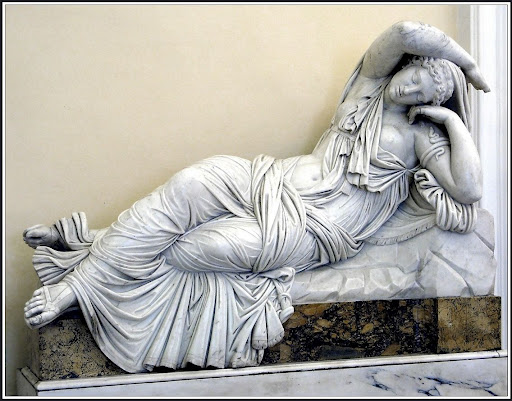 “Today she is known as the Vatican Sleeping Ariadne, long called Cleopatra.”
“Today she is known as the Vatican Sleeping Ariadne, long called Cleopatra.”
In the Vatican sits a beautiful Parian marble sculpture of a goddess who has a bracelet on the upper part of her left arm in the form of a serpent; called by the ancients, Ophis. The word ophis, is Greek for serpent. The name of the goddess is Ariadne who was originally worshipped on the holy island of Crete. She was the daughter of the famous law giver of Crete, King Minos; today she is known as the Vatican Sleeping Ariadne, long called Cleopatra.
Ariadne was seduced by the mythical founder-king of Athens, son of Aegeus and Poseidon, Theseus who was sent to Crete in order to destroy the Minotaur bull. When Theseus arrived in Crete, with the help of Aphrodite; Ariadne had fallen deeply in love with Theseus and offered to help him out of the labyrinth, if he had agreed to marry her and take her back with him to Athens. In return for his promise of marriage, she gave him a ball of thread to help him find his way out of the labyrinth.
She was originally the “Mistress of the Labyrinth“, both a winding dance-ground and in the Greek view a prison with the dreaded Minotaur at its centre. Kerenyi notes a Linear B inscription from Knossos, “to all the gods, honey… to the mistress of the labyrinth honey” in equal amounts, suggesting to him that the Mistress of the Labyrinth was a Great Goddess in her own right. Professor Barry Powell has suggested she was Minoan Crete’s Snake Goddess.(Wikipedia)
The colossal statue of Ariadne located in the Vatican was made in approximately 100 AD, during the reign and empire of the Roman Emperor, Hadrian. She is shown sleeping on the rocks of Naxos, where she had been left by Theseus after she had assisted him in freeing himself from the labyrinth of Crete, in which he had been imprisoned. Eventually she married the god Dionysus or Bachhus.
The name Ariadne means “most holy”, composed of the Cretan Greek elements αρι (ari) “most”, and αδνος (adnos) “holy”.
In the image below of the original statue, Ariadne lies there asleep in the Vatican; below her there are various daemons and serpents (Ophites), who are fallen or chained angels attempting to redeem themselves to a godlike status in order to reach heaven again. (1)
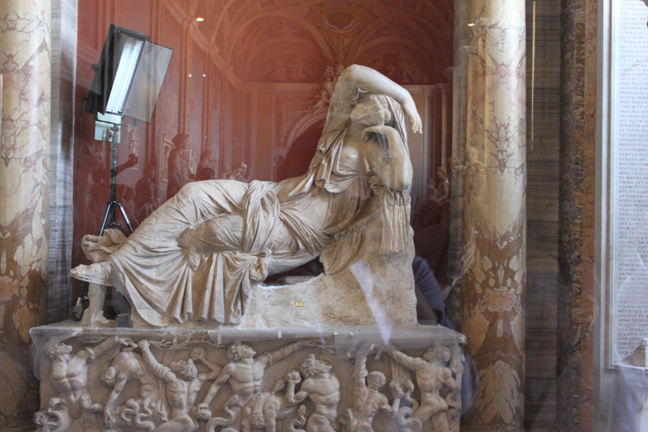
SOURCES:
1. A general and bibliographical dictionary of the fine arts By James Elmes
Moe is the founder of GnosticWarrior.com. He is a father, husband, author, martial arts black belt, and an expert in Gnosticism, the occult, and esotericism.
by Moe | Oct 20, 2013 | Apocalypse
“It would take 6,480 people to each raise $100, just to pay the salary of the CEO of the Susan G. Komen for the Cure.”
I have studied various charities and have found, that most ALL big ones are basically scams in which the CEO’s are pirates who employ ignorant people to work for free in order to raise money, and that much of it goes to their salaries before it EVER goes to someone who has cancer.
For example, the CEO of Susan G. Komen for the Cure – Nancy Brinker now makes $684,000 a year, a 64 percent raise. “This pay package is way outside the norm. It’s about a quarter of a million dollars more than what we see for charities of this size. This is more than the head of the Red Cross is making, for an organization that is one-tenth the size of the Red Cross.”
That would take 6,480 people to each raise $100, just to pay the salary of the CEO of the Susan G. Komen for the Cure.
Maybe it would be best to take that $100 and give it directly to a cancer patient yourself, rather than to a CEO who makes $684,00 a year?
Moe is the founder of GnosticWarrior.com. He is a father, husband, author, martial arts black belt, and an expert in Gnosticism, the occult, and esotericism.
by Moe | Oct 18, 2013 | Apocalypse, History of the Brotherhood, Tattoos
The tattooed skin of Epimenides was preserved at the courts of the ephores in Sparta, allegedly as a good-luck charm. 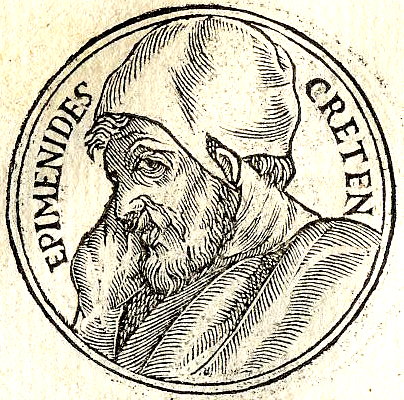
One of the founders of the ancient Gnostic mysteries of Orphism, was said to be a Cretan man named Epimenides (Greek: Ἐπιμενίδης), whose tattooed body and skin were held venerable by the ancient Spartans because it was said to reveal “secret things.” Epimenides had lived in the 7th century B.C. and was born in the city of Gnosis, which today is called the city of Knossos on the modern-day island of Crete in the Mediterranean Sea.
To the Spartans, he was the chief shaman of their people, who was not only a seer, poet and advisor, but he was also a prophet who specialized in searching the past for truth. Hence, his knowledge was retrospective based on his Gnosis which is old knowledge relearned from the blood. A talent, that was once respected by the ancients and the world’s most powerful people for thousands of years. (more…)
Moe is the founder of GnosticWarrior.com. He is a father, husband, author, martial arts black belt, and an expert in Gnosticism, the occult, and esotericism.
by Moe | Oct 17, 2013 | Apocalypse, History of the Brotherhood
The Apostle John (4 BC – 100 AD) is said to have been born in the city of Ephesus. There are mentioned to be actual records of 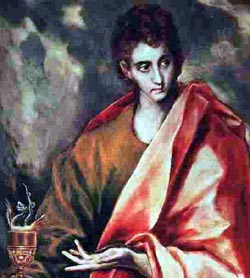 John being arrested by the Emperor Domitian (reigned 81 -96 AD), and then being sent to the small island of Patmos where he had written the Book of Revelation. He was eventually released late in his life of exile from his prison on Patmos, and then returned back to his birthplace of Ephesus where he would convert many Jews to Christianity before his death. Saint John was also buried at Ephesus. A place, that I believe the original city was located on the Holy Island of Crete in the Mediterranean Sea.
John being arrested by the Emperor Domitian (reigned 81 -96 AD), and then being sent to the small island of Patmos where he had written the Book of Revelation. He was eventually released late in his life of exile from his prison on Patmos, and then returned back to his birthplace of Ephesus where he would convert many Jews to Christianity before his death. Saint John was also buried at Ephesus. A place, that I believe the original city was located on the Holy Island of Crete in the Mediterranean Sea.
Today, the city of Ephesus is located in the Selçuk, İzmir Province, Turkey, but I have found that the original ancient city mentioned in the bible was actually on the island of Crete. It simply appears to me, that many of these very old cities were moved or were sister cities created, and that were models of the original ancient cities. This can be easily researched to connect the dots, by anyone who wishes to verify my words that I write in this article with the links to the sources that I provide.
in the early history of the Church, from St. John’s having been banished to it, and having there written his Apocalypse. The modem name is Patmo. 3. Liros lay to the southeast of Patmos. It was peopled from Miletus, and probably belonged to that city. Strabo gives its inhabitants a character for dishonesty. The modern name is Lero. 3. Calymna lay to the southeast of Leros. Ovid praises its honey. It is supposed to have belonged to the group which Homer calls Calydna. The modern name is Ctrfimno. 4. Cos, to the southeast, an island of some celebrity. It must have been inhabited at an early period, since Homer represents it as sending its warriors to the siege of Troy. It was subsequently colonized by a party of Dorians, and hence was always reckoned of Dorian origin, and obtained a place in the Triopian Pentapolis. Its chief city was also called Cos, without the walls of which was a celebrated temple of .Esculapius, containing two famous paintings of Apelles, the Antigonus and Venus Anadyomene. Augustus removed the latter to Rome, and remitted to the Coans, as a compensation for the loss, a tribute of one hundred talents. Cos was the birth-place not only of Apelles, but also of the celebrated physician Hippocrates. It was a very productive island, especially in wine, which vied with that of Lesbos and Chios. Cos was likewise celebrated for its purple dye, and for its manufacture of a species of transparent silk stuff, against the use of which by the Romans Juvenal so strongly inveighs. The modern name of the island is Stan-Co (A System of Ancient and Mediæval Geography for the Use of Schools and Colleges
By Charles Antho)
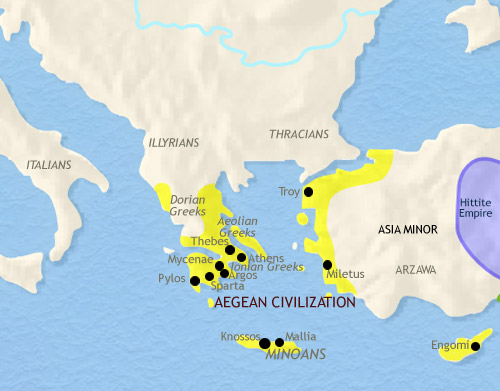 There are many connections and clues tying the City of Ephesus to being located on Crete.
There are many connections and clues tying the City of Ephesus to being located on Crete.
Besides the city of Ephesus being the birthplace and burial site of Saint John, it was also world-famous for the Temple of Artemis (completed around 550 BC). In Greek mythology, Artemis, who was also called Letois was the daughter of the Father of the Gods, Zeus (Jupiter); her mother was the Titan, Leto who was the goddess of motherhood, and with her children, a protectress of the young. Her brother was the God of Healing, Apollo.
In Crete, at the city of Dreros, Spyridon Marinatos uncovered an eighth-century post-Minoan hearth house temple, in which there were found three unique figures of Apollo, Artemis and Leto made of brass sheeting hammered over a shaped core (sphyrelata).
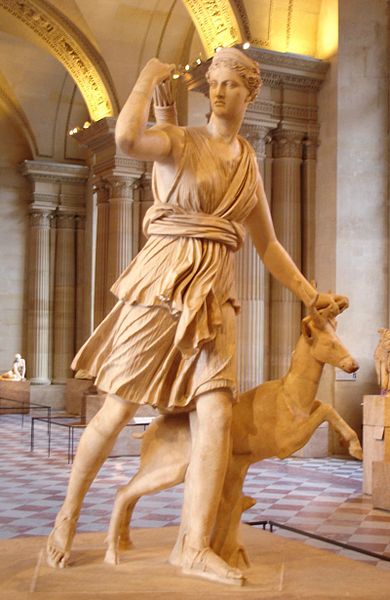 Homer refers to her as Artemis Agrotera, Potnia Theron: “Artemis of the wildland, Mistress of Animals.” The Arcadians believed she was the daughter of Demeter. She was also the protector and goddess of young men and or priesthood who were called the Curetes (Kuretes or Kouretes). The worship of Artemis had originated in Minoan Crete, where she was “goddess of mountains and hunting’, who was the “sweet maiden’ and “sweet virgin,” Britomartis (Βριτόμαρτις).
Homer refers to her as Artemis Agrotera, Potnia Theron: “Artemis of the wildland, Mistress of Animals.” The Arcadians believed she was the daughter of Demeter. She was also the protector and goddess of young men and or priesthood who were called the Curetes (Kuretes or Kouretes). The worship of Artemis had originated in Minoan Crete, where she was “goddess of mountains and hunting’, who was the “sweet maiden’ and “sweet virgin,” Britomartis (Βριτόμαρτις).
Strabo notes she was venerated as Diktynna, only in western Crete in the region of Cydonia, where there was a Diktynnaion , or temple of Diktynna. “Oupis [Artemis], O queen, fairfaced Bringer of Light, thee too the Kretans name after that Nymph,” Callimachus says. “She passed her time in the company of Artemis, this being the reason why some men think Diktynna and Artemis are one and the same goddess,” Diodorus Siculus (5.76.3) suggested.
By Hellenistic and Roman times, Britomartis was given a genealogical setting that fitted her into a Classical context: “Britomartis, who is also called Diktynna, the myths relate, was born at Kaino in Crete of Zeus and Karme,[8] the daughter of Euboulos who was the son of Demeter; she invented the nets [diktya] which are used in hunting.”
The reason I relate these stories to you, is for reference to Greek mythology and is because this all takes place on the island of Crete. In addition, one of the best authorities on the subject would be Strabo who was a native from Crete. Hence, it only makes sense, that if Zeus was born on Crete and the legend has it that he was hidden in a cave on Mount Ida on the same island where he would father other Gods and Goddesses such as Artemis and Apollo, that these temples and the main home for them would be on the same holy land. It was only after the Romans had taken over Crete and the religion of the Greek Jews, that they would then change many of the names of these goddesses and Gods; where Artemis then, became known as “Diana of Ephesus” and her Temple from then on was called, “The Temple of Diana.”
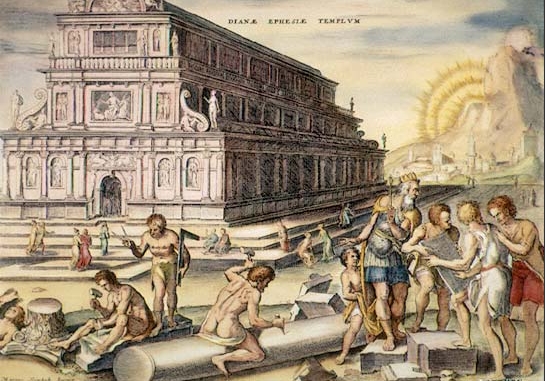 The Temple of Artemis (Diana) was one of the Seven Wonders of the Ancient World. In the 7th century BC, the old temple was destroyed by a flood. Its reconstruction began around 550 BC. under the Cretan architect Chersiphron and his son Metagenes, at the expense of Croesus of Lydia: the project took 10 years to complete, only to be destroyed in an act of arson by Herostratus. It was later rebuilt in 268 AD., and the Temple was destroyed or damaged yet again in a raid by the Goths. In Greek and Roman historical tradition, the temple’s destruction coincided with the birth of Alexander the Great (around 20/21 July 356 BC). Plutarch remarked, that Artemis was too preoccupied with Alexander’s delivery to save her burning temple. (Wikpedia)
The Temple of Artemis (Diana) was one of the Seven Wonders of the Ancient World. In the 7th century BC, the old temple was destroyed by a flood. Its reconstruction began around 550 BC. under the Cretan architect Chersiphron and his son Metagenes, at the expense of Croesus of Lydia: the project took 10 years to complete, only to be destroyed in an act of arson by Herostratus. It was later rebuilt in 268 AD., and the Temple was destroyed or damaged yet again in a raid by the Goths. In Greek and Roman historical tradition, the temple’s destruction coincided with the birth of Alexander the Great (around 20/21 July 356 BC). Plutarch remarked, that Artemis was too preoccupied with Alexander’s delivery to save her burning temple. (Wikpedia)
Antipater of Sidon of Crete from around 140 BC, had named six of the seven sites on his list—leaving out the lighthouse—, but was primarily in praise of the Temple of Artemis at Ephesus:
I have gazed on the walls of impregnable Babylon along which chariots may race, and on the Zeus by the banks of the Alpheus, I have seen the hanging gardens, and the Colossus of the Helios, the great man-made mountains of the lofty pyramids, and the gigantic tomb of Mausolus; but when I saw the sacred house of Artemis that towers to the clouds, the others were placed in the shade, for the sun himself has never looked upon its equal outside Olympus.
— Greek Anthology IX.58
St. John had opposed a man in Ephesus named ‘Cerinthus,’ who was a Jewish Christian and the alleged Gnostic arch-heretic. Ephesus was one of the seven churches of Asia that are cited in the Book of Revelation. Hence, it was one of the most important religious centers of all the world at the time, and it would continue to be for many centuries, even after it was conquered by the Romans. The story of St. John, the Gnostic Cerinthus and his followers, I will write on in the near future.
Christianity in the city of Ephesus, was introduced in the 1st century AD by Paul the Apostle who visited Ephesus around 53 AD, where he spent three months teaching in a synagogue in an effort to bring the Greek Jews to accept union with the gentiles of Rome in Christianity, but he met with little success. For the next two years he stayed in Ephesus on Crete, where he appears to have made many converts.
One of his Gentile converts was actually a Roman Emperor by the name, Titus who would later become the companion of Paul 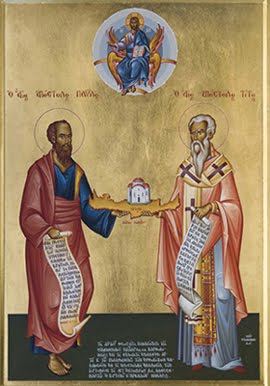 who had appointed him Bishop of Crete after the siege of the City of Jerusalem and the destruction of the Temple. Hence, the Roman Emperor Titus became master of the island of Crete after he had conquered the government and religion, where he then would be immortalized in the Catholic Church as Saint Titus forever thereafter.
who had appointed him Bishop of Crete after the siege of the City of Jerusalem and the destruction of the Temple. Hence, the Roman Emperor Titus became master of the island of Crete after he had conquered the government and religion, where he then would be immortalized in the Catholic Church as Saint Titus forever thereafter.
Titus 1:5-9 – I (Paul) left you (Titus as minister) in Crete to set right matters which needed attention, and gave you instructions to appoint elders in every city. They were to be men of unquestioned integrity with only one wife, and with children brought up as Christians and not likely to be accused of loose living or law-breaking. To exercise spiritual oversight a man must be of unimpeachable virtue, for he is God’s agent in the affairs of his household. He must not be aggressive or hot-tempered or over-fond of wine; nor must he be violent or greedy for financial gain. On the contrary, he must be hospitable, a genuine lover of what is good, a man who is discreet, fair-minded, holy and self-controlled: a man who takes his stand on the orthodox faith, so that he can by sound teaching both stimulate faith and confute opposition.
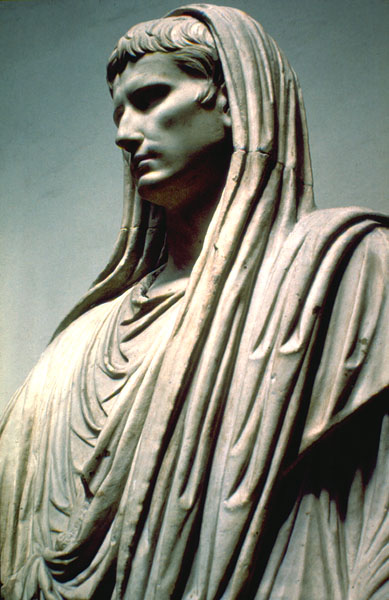 When Augustus Caesar became Roman Emperor in 27 BC, he made Ephesus the capital of proconsular Asia (which covered western Asia Minor) instead of Pergamum. He had built a city to his name nearby Ephesus called, Caesaria, which at the time of Paul was the seat of where, the then governor of Idaea or Judea (Tribe of Judah) had resided. The Cretans were called back then, the ‘Idaeans’ and according to Homer, one of their rulers was known as ‘Idomensus,’ the grandson of the ruler of Knossos. The children of Idomensus were, whom Homer had called the royal and warlike ‘Idomen,‘ and who we would know of today as the Judeans (Idaeans, Tribe of Judah). Ephesus then entered an era of prosperity, becoming both the seat of the governor and a major center of commerce.
When Augustus Caesar became Roman Emperor in 27 BC, he made Ephesus the capital of proconsular Asia (which covered western Asia Minor) instead of Pergamum. He had built a city to his name nearby Ephesus called, Caesaria, which at the time of Paul was the seat of where, the then governor of Idaea or Judea (Tribe of Judah) had resided. The Cretans were called back then, the ‘Idaeans’ and according to Homer, one of their rulers was known as ‘Idomensus,’ the grandson of the ruler of Knossos. The children of Idomensus were, whom Homer had called the royal and warlike ‘Idomen,‘ and who we would know of today as the Judeans (Idaeans, Tribe of Judah). Ephesus then entered an era of prosperity, becoming both the seat of the governor and a major center of commerce.
According to Strabo, the city of Ephesus was second in importance and size only to Rome.
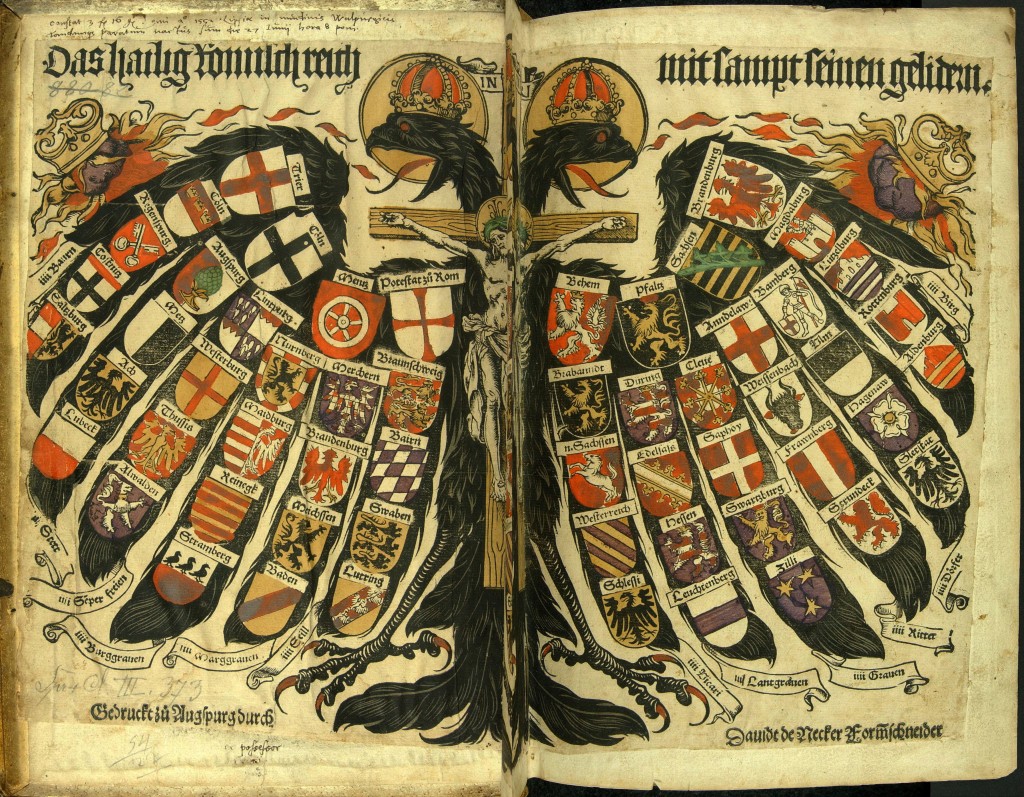
MORE FACTS CONNECTING SAINT JOHN AND THE CITY OF EPHESUS TO CRETE (Open Source)
Two decades later, the church at Ephesus was still important enough to be addressed by a letter written by Bishop Ignatius of Antioch to the Ephesians in the early 2nd century AD, that begins with, “Ignatius, who is also called Theophorus, to the Church which is at Ephesus, in Asia, deservedly most happy, being blessed in the greatness and fullness of God the Father, and predestinated before the beginning of time, that it should be always for an enduring and unchangeable glory” (Letter to the Ephesians). The church at Ephesus had given their support for Ignatius, who was taken to Rome for execution.
A legend, which was first mentioned by Epiphanius of Salamis in the 4th century AD, purported that Mary may have spent the last years of her life in Ephesus. The Ephesians derived the argument from John’s presence in the city, and Jesus’ instructions to John to take care of Mary after his death. Epiphanius, however, was keen to point out that, while the Bible says John was leaving for Asia, it specifically does not say that Mary went with him. He later stated that she was buried in Jerusalem.
In the 3rd century, the emperor Constantine I rebuilt much of the city of Ephesus, and erected a new public bath. Constantine the Great frequently traveled to Nicomedia in Crete near Ephesus and had made this city his place of residence. He later died near his home in the year 337.’ Ephesus remained the most important city of the Byzantine Empire in Asia after Constantinople in the 5th and 6th centuries.
Moe is the founder of GnosticWarrior.com. He is a father, husband, author, martial arts black belt, and an expert in Gnosticism, the occult, and esotericism.
 “Today she is known as the Vatican Sleeping Ariadne, long called Cleopatra.”
“Today she is known as the Vatican Sleeping Ariadne, long called Cleopatra.”











